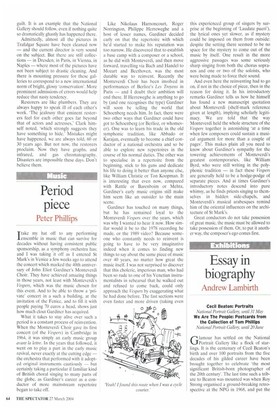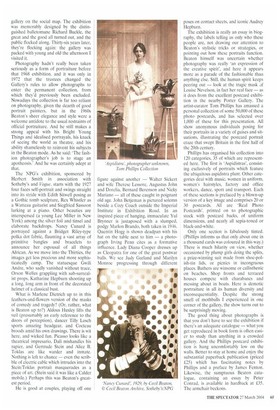Essay in biography
Andrew Lambirth
Cecil Beaton: Portraits National Portrait Gallery, until 31 May We Are The People: Postcards from the Collection of Tom Phillips National Portrait Gallery, until 20 June
Glamour has settled on the National Portrait Gallery like a flock of starlings. It is the centenary of Cecil Beaton's birth and over 100 portraits from the five decades of his gilded career have been brought together to celebrate 'the most significant British-born photographer of the 20th century'. The last time such a tribute to Beaton was mounted was when Roy Strong organised a ground-breaking retrospective at the NPG in 1968, and put the
gallery on the social map. The exhibition was memorably designed by the distinguished balletomane Richard Buckle, the great and the good all turned out, and the public flocked along. Thirty-six years later, they're flocking again: the gallery was packed with young and old the afternoon I visited it.
Photography hadn't really been taken seriously as a form of portraiture before that 1968 exhibition, and it was only in 1972 that the trustees changed the Gallery's rules to allow photographs to enter the permanent collection, from which they'd previously been excluded. Nowadays the collection is far too reliant on photography, given the dearth of good portrait painters, but in the 1960s Beaton's sheer elegance and style were a welcome antidote to the usual restraints of official portraiture. And he still makes a strong appeal with his Bright Young Things and idealised portrayals, his knack of seeing the world as theatre, and his ability shamelessly to reinvent his subjects in the Beaton mode. As he said: The fashion photographer's job is to stage an apotheosis.' And he was certainly adept at that.
The NPG's exhibition, sponsored by Herbert Smith in association with Sotheby's and Vogue, starts with the 1927 four faces self-portrait and swings straight into its stride with Edith Sitwell posing as a Gothic tomb sculpture, Rex Whistler as a Watteau guitarist and Siegfried Sassoon lurking at a piano. Other beauties are interspersed (a young Lee Miller in New York) among the silver foil and tinsel and elaborate backdrops. Nancy Cunard is portrayed against a Bridget Riley-type polka dot fabric, flaunting a vast array of primitive bangles and bracelets to announce her espousal of all things African, As we move into the Thirties, the images get less precious and more sophisticatedly camp. The statuesque Gwili Andre, who sadly vanished without trace, Orson Welles grappling with sub-surrealist props, Katharine Hepburn shooting up a long, long arm in front of the decorated helmet of a classical bust.
What is Marlene Dietrich up to in this feathers-and-flowers version of the masks of comedy and tragedy? (Or, rather, what is Beaton up to?) Aldous Huxley lifts the veil (presumably an early reference to the doors of perception), dancer Tilly Losch sports amazing headgear, and Cocteau broods amid his own drawings. There is wit here, and wicked fun. Picasso looks like a theatrical impresario, DaLI mishandles his rapier, and Gertrude Stein and Alice B. Toklas are like warder and inmate. Nothing is left to chance — even the scribble of electric cable which intrudes into the Stein/1'0klas portrait masquerades as a piece of art. (Stein said it was like a Calder mobile.) Perhaps this was Beaton's greatest period.
He is good at couples, playing off one figure against another — Walter Sickert and wife Therese Lessore, Augustus John and Dorelia, Bernard Berenson and Nicky Mariano — all of these caught in poignant old age. John Betjeman is pictured solemn beside a Cozy Coach outside the Imperial Institute in Exhibition Road. In an inspired piece of hanging, immaculate Yul Brynner is juxtaposed with a slumped, podgy Marlon Brand°, both taken in 1916. Quentin Hogg is shown deadpan with his hat on the table next to him — a photograph Irving Penn cites as a formative influence. Lady Diana Cooper dresses up as Cleopatra for one of the great postwar balls. We see Judy Garland and Marilyn Monroe progressing through different poses on contact sheets, and iconic Audrey Hepburn.
The exhibition is really an essay in biography, the labels telling us only who these people are, not drawing our attention to Beaton's stylistic tricks or strategies, or pointing out how these portraits function. Beaton himself was uncertain whether photography was really 'an expression of the creative spirit', and here it appears more as a parade of the fashionable than anything else. Still, the human spirit keeps peering out — look at the tragic mask of Louise Nevelson. in fact her real face — as it does from the excellent postcard exhibition in the nearby Porter Gallery. The artist-curator Tom Phillips has amassed a personal collection of some 50,000 of these photo postcards, and has selected over 1,000 of these for this presentation. All show anonymous individuals posing for their portraits in a variety of guises and situations, illustrating the postcard portrait craze that swept Britain in the first half of the 20th century.
Phillips has organised his collection into 120 categories, 35 of which are represented here. The first is 'Aspidistras', consisting exclusively of portraits which feature the ubiquitous aspidistra plant. Other categories deal with music, women in uniform, women's hairstyles, factory and office workers, dance, sport and transport. Each of these sections is prefaced by a blown-up version of a key image and comprises 20 or 30 postcards. All are 'Real Photo Postcards', printed on to photographic stock with postcard backs, of uniform dimensions, and nearly all sepia-toned or black-and-white.
Only one section is fabulously tinted. (Phillips informs us that only about one in a thousand cards was coloured in this way.) There is much hilarity on view, whether occasioned by plump girls doing the splits, a prize-winning suit made from shoe-polish-tin lids, or picnics in incongruous places. Bathers are winsome or callisthenic on beaches. Shop fronts and terraced houses compete with charabancs and messing about in boats. Here is demotic portraiture in all its human diversity and inconsequentiality. Despite the strong smell of mothballs I experienced in one corner of the gallery, the show turns out to be surprisingly moving.
The good thing about photographs is that you don't have to see the exhibition if there's an adequate catalogue — what you get reproduced in book form is often easier to study than anything in a crowded gallery. And the Phillips postcard exhibition is hung uncomfortably low on the walls. Better to stay at home and enjoy the substantial paperback publication (priced £25) which has fascinating notes by Phillips and a preface by James Fenton. Likewise, the sumptuous Beaton catalogue, containing an essay by Peter Conrad, is available in hardback at £35. The armchair beckons.



























































































 Previous page
Previous page